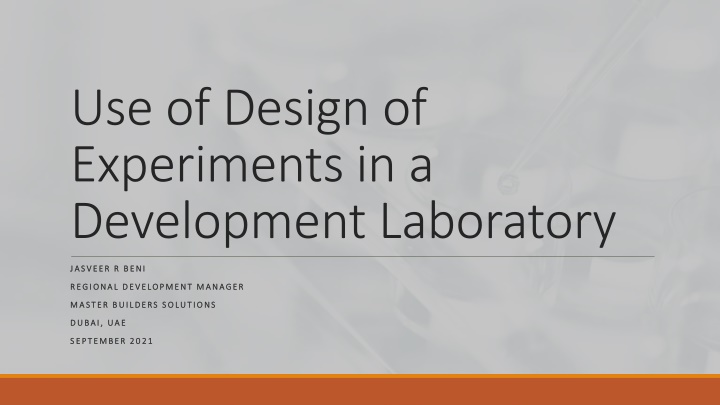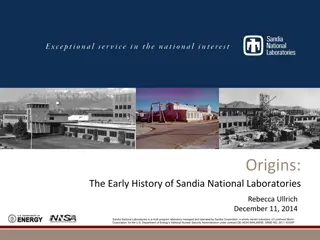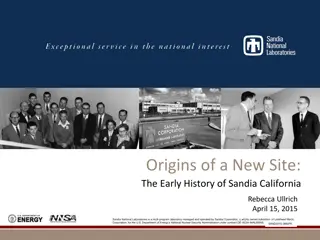Utilizing Design of Experiments in Development Laboratories
Design of Experiments (DoE) is a crucial methodology in product development laboratories, enabling faster analysis of multiple factors and interactions. This approach accelerates the product development process and enhances competitiveness in the industry. By incorporating statistical tools and well-designed experiments, organizations can improve effectiveness and share valuable insights across geographical regions.
Download Presentation

Please find below an Image/Link to download the presentation.
The content on the website is provided AS IS for your information and personal use only. It may not be sold, licensed, or shared on other websites without obtaining consent from the author.If you encounter any issues during the download, it is possible that the publisher has removed the file from their server.
You are allowed to download the files provided on this website for personal or commercial use, subject to the condition that they are used lawfully. All files are the property of their respective owners.
The content on the website is provided AS IS for your information and personal use only. It may not be sold, licensed, or shared on other websites without obtaining consent from the author.
E N D
Presentation Transcript
Use of Design of Experiments in a Development Laboratory JASVEER R BENI JASVEER R BENI REGIONAL DEVELOPMENT MANAGER REGIONAL DEVELOPMENT MANAGER MASTER BUILDERS SOLUTIONS MASTER BUILDERS SOLUTIONS DUBAI, UAE DUBAI, UAE SEPTEMBER 2021 SEPTEMBER 2021
Context Overview Why Design of Experiments (DoE) ? Some Key Usage of DoE Main Uses of DoE Prerequisites for successful designs Practical Examples Benefits of using DoE Contents
Context Overview Context Overview We have several product development laboratories spread geographically across the Middle East, Africa and Asia Pacific aimed at adapting our global product portfolio to local market requirements Some of the key activities undertaken by the lab personnel include: New product development Evaluation of new raw materials Cost engineering and product optimization/improvement Improving product robustness Our activities involve working with different chemistries widely used within our industry such as Reactive resins Dispersions Cementitious technologies
Why Design of Experiment ? Design of Experiments was one of the key methodologies introduced Compared to the classic method of One Factor at A time experimenting, DoE help analyzing several factors and interactions in a shorter amount of time, hence speeding up the product development process To cope with increased competitiveness in the industry, several statistical tools were introduced in our technical community to improve effectiveness and further complement the technical skills of the existing personnel A properly designed experiment will yield results which are valid over a broad environment (internal and external variables) which facilitates information and formulation exchanges across our large geographical region
Some key usages of DoE Some key usages of DoE Comparison identifying which is the best option among a set of similar raw materials Variable Screening Some products contain upto 20 different components. Using Screening models such as Taguchi L12 or L18 can in many cases help identify the main factors influencing key performance of a certain product Transfer Function Identification: The influence of factors identified via screening or from subject matter experts can be further explored to improve or optimize product performance System Optimization: Transfer functions can further be explored for achieving quality improvement or cost engineering Robust Designs: deals with the reduction of variation caused generally by uncontrollable factors . Product performance and quality defects are often related to variations caused by either External environmental factors (temperature, humidity, on site storage conditions) Internal factors (shelf life of product or key raw materials, manufacturing processes) Unit to Unit variations (consistency of manufacturing process, quality of raw materials)
Prerequisites for DoE Prerequisites for DoE Well defined objectives: factors and appropriate levels; experimental procedure and equipment and applicability of outputs Define Suitable Type of Design based on desired output (Screening, Modelling, Optimization) Experiment should be designed in a way to minimize the effects of uncontrollable variables Background variables (Noises) Test equipment should be bias free (randomization and replications) and provide a measure of precision (Measurement System Analysis can help identify and reduce errors) Ability to properly use Data Analysis Tools to interpret results(Regression, ANOVA etc) Conclusions and recommendations should be practical
Practical Example 1 Screening Design for Identifying main factors influencing key performance parameters for new cementitious product development Taguchi L16 Regression Analysis Investigating the key factors influencing a key mechanical characteristic of a product without having to do deep chemical analysis for all possible reactions and interactions Further investigation carried out only for the highest influencing parameter/interaction Sped up key stage of development from 6 to 2 weeks
Practical Example 2: Fractional Factorial design for Regression Modelling to serve as a formulation tool The Optimization option was used as a formulation guideline for developing new products based on the raw materials investigated above. Time to Market for new product using completely new technology was reduced from 2 years to 1 year Localizing same product in various countries was also made easier by using data garnered from the DoE
Benefits of Design of Experiments Benefits of Design of Experiments Increased effectiveness of development teams Reduced time to market for new products Identifying interactions between factors which otherwise would have gone overlooked without always having to go deep into chemistry Technical Personnel get more used to taking systematic approaches in their tasks, adopting critical analysis, using tools to analyze and present data Optimized usage of available resources and less waste Knowledge exchange between teams from different countries/cultures becomes simple Helps overcome language barriers by implementing a common technical language understood throughout the technical community























